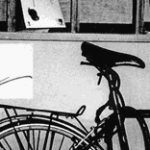
Not just for night-joggers anymore
Chicago fashion designer and visiting artist from Germany, Anke Loh, became the first designer to collaborate with the Dutch-based Royal Philips Electronics company last month.
Loh, who currently teaches in SAIC’s fashion department, is the first fashion designer to incorporate Lumalive in her work. She used the technology to display video of Chicago and Antwerp’s city life. The square panels occupy the fronts of her black and cream dresses. Loh’s designs were clean, sleek, and restrained, yet elegant.
Lumalive first debuted at the 2006 world consumer electronics fair, IFA (Internationale Funkausstellung) in Berlin, where Royal Philips promoted the material with jackets, couches, backpacks with personalized messages, pillows with mood lighting, and fabric squares that accepted text messages.
Photonic Textiles technology works with panels of LEDs (light-emitting diodes) that are fully integrated into the designed object, complete with control units and batteries.
The panels, a separate layer behind the fabric, are flexible and can display an array of colors in the form of animations, text, logos and changing patterns. Panels can also be designed with continuous, ambient mood lighting and can be programmed to interact with nearby music devices and cell phones.
“This collection features an experiment integrating light into a spectrum of fabrics we use for our second skin—clothing,’’ explains Loh, who collaborated with a fiber artist to weave optical fibers with black cotton on a jacquard loom.
“With Lumalive from Philips, I found the possibility to have moving images in the clothes,” she continues. “Already [for] a long time I am very interested in developing my concepts for each collection into video. With Lumalive, I got the possibility to bring clothes and video together in one item. I am very convinced that this technology will allow artists and designers in different areas to approach communication through clothes, furniture and objects. in a new way. All the reactions I received to this project showed the curiosity of people around the world about the endless possibilities when combining art, movement, light and technology.”
Technology’s relationship with fashion has certainly grown since the invention of the first manufactured fabric, Rayon, in 1855. Though technologically advanced materials seem to be replacing those from the natural world, most students and designers won’t be buying or working with Lumalive even after it becomes available for commercial use in 2007, due to its impractically high price tag.
Loh invited Bas Zeper, Managing Director of Photonic Textiles at Royal Philips, to present Lumalive Photonic Textiles during Loh’s fashion show. The show presented her use of the non-traditional textile in a non-traditional fashion show setting: the glass-encased entryway of one North Wacker Drive. An international crowd gathered at 8 p.m. to take a peek at the softly glowing dresses, following an introduction to the product by Zeper.
Those who attended Bas Zeper’s presentation preceding the fashion show had many questions about the fabric’s warming affects, use for health purposes or light therapy, washability, bulkiness, and the LED’s weaving capabilities.
Zeper said people will want their product to be “flexible, durable and operated by reasonably compact batteries,” and “fitting all that into a comfortable, lightweight garment is a considerable engineering success.” Though Lumalive has many benefits and is safe to use, consumers will have to consider the discomfort of Photonic Textiles’ slight warming at the end of the day, lack of breathability as well as the awkward removal of the panel for washing.
“Sometimes, people are so impressed by the new technology that it takes away the viewers’ focus from the actual garments,” said Cherry Yuen, an SAIC fashion student who saw the show. “Instead of [being] overwhelmed by the Lumalive technology, the designer had a great approach in the forms and structures of the garments.”
“I thought it was unearthly, futuristic, but graceful,” agreed Writing student Naomi Edwards.
Loh was pleased to work with Lumalive Technology. “It’s the perfect combination of art and technology,” she explained, “It takes personal expression to a new level. It has limitless possibilities and my collection is just the beginning.”





















